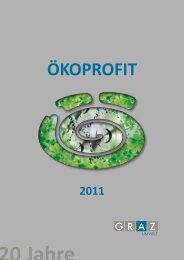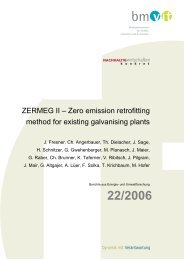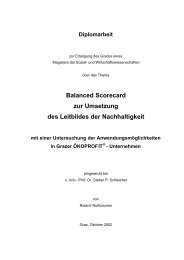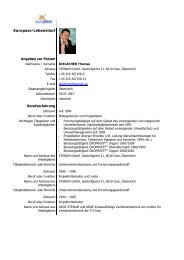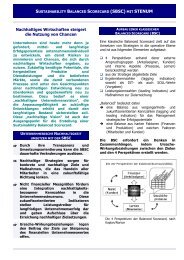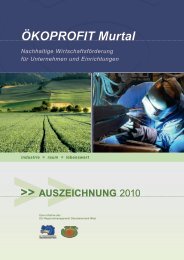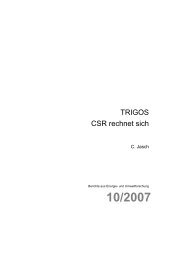Promoting Resource Efficiency in Small & Medium size ... - UNEP
Promoting Resource Efficiency in Small & Medium size ... - UNEP
Promoting Resource Efficiency in Small & Medium size ... - UNEP
You also want an ePaper? Increase the reach of your titles
YUMPU automatically turns print PDFs into web optimized ePapers that Google loves.
8.2 WHY:<br />
Chemical efficiency benefits for SMEs<br />
In recent years, treatment and disposal costs for hazardous wastes<br />
have risen, while regulatory fees and paperwork associated with toxic<br />
materials have become <strong>in</strong>creas<strong>in</strong>gly steep.<br />
Aga<strong>in</strong>st the backdrop of the soar<strong>in</strong>g costs and liability exposure<br />
associated with the use of hazardous materials, it makes <strong>in</strong>creas<strong>in</strong>g<br />
economic sense to <strong>in</strong>vest <strong>in</strong> alternative substances and processes<br />
that reduce reliance on <strong>in</strong>dustrial toxics wherever possible. Reduc<strong>in</strong>g<br />
the usage of tox<strong>in</strong>s helps manufacturers to improve their production<br />
efficiency and achieve other goals traditionally associated with quality<br />
improvement programmes. It can help bus<strong>in</strong>esses to economise on<br />
materials, cut production time, improve product quality, decrease<br />
transport, treatment and disposal costs, reduce regulatory fees and<br />
compliance headaches, improve worker safety and cut worker’s<br />
compensation <strong>in</strong>surance rates. 87<br />
Of the 5-7 million known chemical substances, companies use<br />
more than 80,000 <strong>in</strong> their production processes and operations.<br />
Numerous new chemicals are discovered and produced each year.<br />
Today, almost every company uses some type of chemical. Those<br />
enterprises that manage chemicals efficiently can ga<strong>in</strong> concrete<br />
benefits.<br />
Grow<strong>in</strong>g consumer consciousness of environmental and social issues<br />
has led to the creation of requirements that suppliers must meet to have<br />
their products accepted <strong>in</strong> many <strong>in</strong>ternational markets. By identify<strong>in</strong>g<br />
and reduc<strong>in</strong>g the use of banned chemicals and hazardous substances,<br />
companies can improve their competitive position and make the<br />
communities where their operations are located safer. Moreover, by<br />
improv<strong>in</strong>g the management of chemicals, companies are simultaneously<br />
mov<strong>in</strong>g towards meet<strong>in</strong>g the requirements of management system<br />
standards such as ISO 9000 (quality) and 14000 (environment). ISO<br />
certification would be helpful leverage for w<strong>in</strong>n<strong>in</strong>g contracts. For<br />
example, many of the activities required for Environmental Management<br />
Systems (EMS) certification are aimed at reduc<strong>in</strong>g the use of hazardous<br />
substances, protect<strong>in</strong>g the health of workers and reduc<strong>in</strong>g negative<br />
effects on the natural environment; these three improvements will <strong>in</strong><br />
turn also improve the quality of a company’s product.<br />
• Improved worker health and safety<br />
Chemicals alone or mixed with other substances can cause<br />
<strong>in</strong>jury, disease, or even death for people handl<strong>in</strong>g these materials.<br />
The misuse of chemicals may result <strong>in</strong> fires and explosions.<br />
Accidents <strong>in</strong>volv<strong>in</strong>g chemicals create additional costs for<br />
companies <strong>in</strong> terms of lost materials, damaged equipment and<br />
facilities, and personal <strong>in</strong>jury. Reduc<strong>in</strong>g health and safety risks<br />
for employees improves their motivation and productivity and<br />
reduces absenteeism due to <strong>in</strong>jury and illness. 88<br />
Reduc<strong>in</strong>g<br />
environmental<br />
impact<br />
Reduc<strong>in</strong>g<br />
production costs<br />
Triplew<strong>in</strong><br />
Improv<strong>in</strong>g worker<br />
safety and health<br />
Institutional<br />
learn<strong>in</strong>g by<br />
improvement of<br />
communication<br />
8.3 HOW:<br />
Establish a chemical management programme<br />
Step 1: Identify Substances<br />
Step 1 expla<strong>in</strong>s how to create a structured <strong>in</strong>formation base that can<br />
be used to make cont<strong>in</strong>ual improvements towards chemical efficiency<br />
<strong>in</strong> your company. It <strong>in</strong>volves systematically identify<strong>in</strong>g all chemical<br />
substances stored and <strong>in</strong> use <strong>in</strong> your company.<br />
Chemical Inventory<br />
Establish<strong>in</strong>g an <strong>in</strong>ventory of hazardous chemicals allows for:<br />
Figure 41: Triple W<strong>in</strong> 86<br />
Benefits of chemical efficiency<br />
Adopted from the “Chemical Management Guide for SMEs” (Federal<br />
M<strong>in</strong>istry for Economic Cooperation and Development, Germany)<br />
• Reduced cost and environmental impact<br />
Chemicals can represent a major part of the production cost for<br />
companies. Any measures that can be taken to reduce the loss,<br />
waste, contam<strong>in</strong>ation and expiry of these substances will br<strong>in</strong>g<br />
cost sav<strong>in</strong>gs to companies and at the same time, reduce their<br />
environmental impact.<br />
• Competitive advantage<br />
While chemicals are often used to achieve certa<strong>in</strong> characteristics<br />
and qualities <strong>in</strong> a product – consumers are <strong>in</strong>creas<strong>in</strong>gly resistant<br />
to the presence of harmful chemicals <strong>in</strong> the products they buy<br />
or <strong>in</strong> the environment. Companies that avoid us<strong>in</strong>g banned and<br />
restricted substances can avoid hav<strong>in</strong>g their products rejected <strong>in</strong><br />
the marketplace. Customers and the community will appreciate<br />
companies who voluntarily absta<strong>in</strong> from us<strong>in</strong>g illegal chemicals<br />
that have negative health and environmental attributes.<br />
• A better understand<strong>in</strong>g of where some of the ma<strong>in</strong> chemical<br />
hazards <strong>in</strong> your company are located<br />
• An opportunity to identify risk reduction actions through stock<br />
control and storage practices before tragedy strikes<br />
• An opportunity to optimise stocks and orders, and to cut costs<br />
• Identification of redundant products<br />
• Identification of unknown substances, which can then be used<br />
before they expire or can be properly disposed of<br />
• Reduc<strong>in</strong>g losses due to substances expir<strong>in</strong>g <strong>in</strong> storage<br />
• Check<strong>in</strong>g the condition of the packag<strong>in</strong>g (damaged, wet,<br />
leak<strong>in</strong>g, etc.)<br />
• Avoid<strong>in</strong>g accidents, fires, and explosions from <strong>in</strong>compatible<br />
materials stored together or mixed <strong>in</strong>appropriately<br />
What do you need to know about the chemicals stored and used at your<br />
company?<br />
• Types of chemicals<br />
• Characteristics/properties<br />
• Place of use/storage<br />
• Type of conta<strong>in</strong>ment/conta<strong>in</strong>er<br />
• Average quantities<br />
86) Tischer M., Scholaen S., Chemical Management and Control Strategies: Experiences from the GTZ Pilot Project on Chemical Safety <strong>in</strong> Indonesian <strong>Small</strong> and <strong>Medium</strong>-<strong>size</strong>d<br />
Enterprises, 2003.<br />
87) Office Of Technical Assistance, A Practical Guide To Toxics Use Reduction, undated<br />
88) GTZ, Chemical Management Guide for <strong>Small</strong> and <strong>Medium</strong> Sized Enterprises: Improve Chemical Management to Ga<strong>in</strong> Cost Sav<strong>in</strong>gs, Reduce Hazards and Improve Safety, 2008<br />
77




